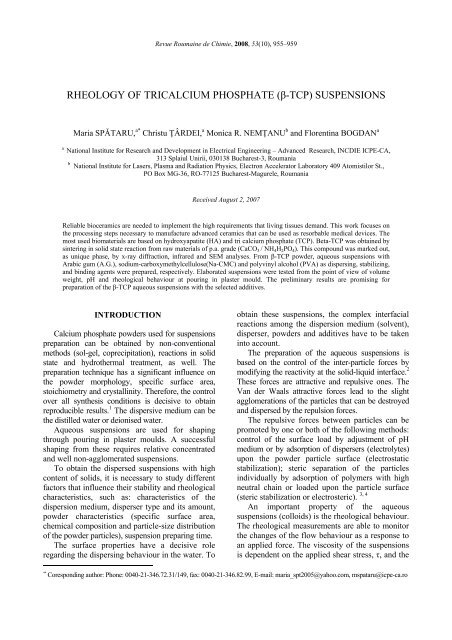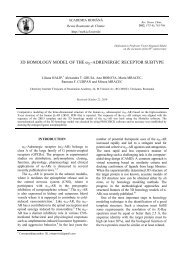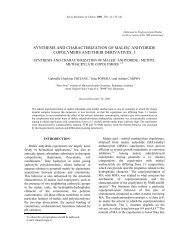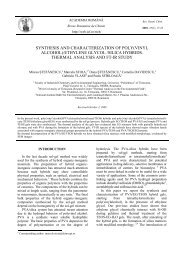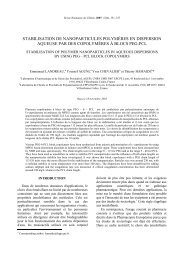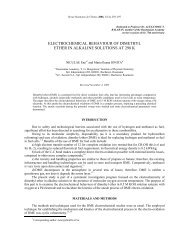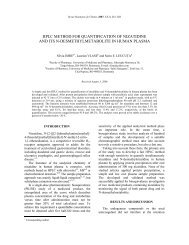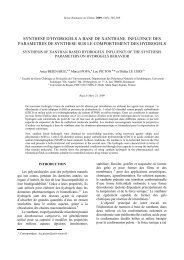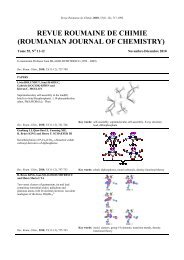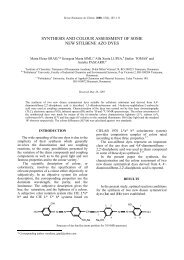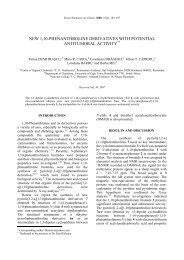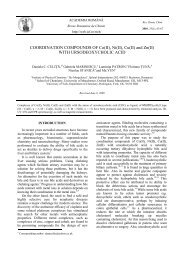RHEOLOGY OF TRICALCIUM PHOSPHATE (β-TCP) SUSPENSIONS
RHEOLOGY OF TRICALCIUM PHOSPHATE (β-TCP) SUSPENSIONS
RHEOLOGY OF TRICALCIUM PHOSPHATE (β-TCP) SUSPENSIONS
You also want an ePaper? Increase the reach of your titles
YUMPU automatically turns print PDFs into web optimized ePapers that Google loves.
Revue Roumaine de Chimie, 2008, 53(10), 955–959<strong>RHEOLOGY</strong> <strong>OF</strong> <strong>TRICALCIUM</strong> <strong>PHOSPHATE</strong> (β-<strong>TCP</strong>) <strong>SUSPENSIONS</strong>Maria SPǍTARU, a* Christu ŢÂRDEI, a Monica R. NEMŢANU b and Florentina BOGDAN aaNational Institute for Research and Development in Electrical Engineering – Advanced Research, INCDIE ICPE-CA,313 Splaiul Unirii, 030138 Bucharest-3, Roumaniab National Institute for Lasers, Plasma and Radiation Physics, Electron Accelerator Laboratory 409 Atomistilor St.,PO Box MG-36, RO-77125 Bucharest-Magurele, RoumaniaReceived August 2, 2007Reliable bioceramics are needed to implement the high requirements that living tissues demand. This work focuses onthe processing steps necessary to manufacture advanced ceramics that can be used as resorbable medical devices. Themost used biomaterials are based on hydroxyapatite (HA) and tri calcium phosphate (<strong>TCP</strong>). Beta-<strong>TCP</strong> was obtained bysintering in solid state reaction from raw materials of p.a. grade (CaCO 3 / NH 4 H 2 PO 4 ). This compound was marked out,as unique phase, by x-ray diffraction, infrared and SEM analyses. From β-<strong>TCP</strong> powder, aqueous suspensions withArabic gum (A.G.), sodium-carboxymethylcellulose(Na-CMC) and polyvinyl alcohol (PVA) as dispersing, stabilizing,and binding agents were prepared, respectively. Elaborated suspensions were tested from the point of view of volumeweight, pH and rheological behaviour at pouring in plaster mould. The preliminary results are promising forpreparation of the β-<strong>TCP</strong> aqueous suspensions with the selected additives.INTRODUCTION ∗Calcium phosphate powders used for suspensionspreparation can be obtained by non-conventionalmethods (sol-gel, coprecipitation), reactions in solidstate and hydrothermal treatment, as well. Thepreparation technique has a significant influence onthe powder morphology, specific surface area,stoichiometry and crystallinity. Therefore, the controlover all synthesis conditions is decisive to obtainreproducible results. 1 The dispersive medium can bethe distilled water or deionised water.Aqueous suspensions are used for shapingthrough pouring in plaster moulds. A successfulshaping from these requires relative concentratedand well non-agglomerated suspensions.To obtain the dispersed suspensions with highcontent of solids, it is necessary to study differentfactors that influence their stability and rheologicalcharacteristics, such as: characteristics of thedispersion medium, disperser type and its amount,powder characteristics (specific surface area,chemical composition and particle-size distributionof the powder particles), suspension preparing time.The surface properties have a decisive roleregarding the dispersing behaviour in the water. Toobtain these suspensions, the complex interfacialreactions among the dispersion medium (solvent),disperser, powders and additives have to be takeninto account.The preparation of the aqueous suspensions isbased on the control of the inter-particle forces bymodifying the reactivity at the solid-liquid interface. 2These forces are attractive and repulsive ones. TheVan der Waals attractive forces lead to the slightagglomerations of the particles that can be destroyedand dispersed by the repulsion forces.The repulsive forces between particles can bepromoted by one or both of the following methods:control of the surface load by adjustment of pHmedium or by adsorption of dispersers (electrolytes)upon the powder particle surface (electrostaticstabilization); steric separation of the particlesindividually by adsorption of polymers with highneutral chain or loaded upon the particle surface(steric stabilization or electrosteric). 3, 4An important property of the aqueoussuspensions (colloids) is the rheological behaviour.The rheological measurements are able to monitorthe changes of the flow behaviour as a response toan applied force. The viscosity of the suspensionsis dependent on the applied shear stress, τ, and the∗∗ Coresponding author: Phone: 0040-21-346.72.31/149, fax: 0040-21-346.82.99, E-mail: maria_spt2005@yahoo.com, mspataru@icpe-ca.ro
956 Maria Spătaru et al.shear rate, γ . The flow behaviour depends on thecomposition and stability of the suspensions.Due to the fact that in the literature data there areonly few pieces of information about the aqueoussuspensions of β-<strong>TCP</strong> and their rheologicalcharacterization, respectively, the purpose of thispaper is to obtain β-<strong>TCP</strong> aqueous suspensions withdifferent additives and to evaluate them fromrheological point of view.RESULTS AND DISCUSSIONβ-<strong>TCP</strong> powderThe β-<strong>TCP</strong> powder prepared in the experimentalconditions presented further was characterised formstructural and morphological point of view.The XRD pattern is shown in Fig. 1.The pattern shows an excellent agreement withthe published JCPDS files for β-<strong>TCP</strong>.The FTIR spectrum of tricalcium phosphatesample is shown in Fig. 2.The range of 800 – 1200 cm -1 exhibits a wideabsorption band typical of tetrahedral anions XO 4 n ,in particular, PO 4 3- . FTIR analysis demonstratedPO 4 3– adsorption peaks around 1040-1122; 610,and 551 cm –1 attributable to ß-<strong>TCP</strong>. 5, 6 FTIRspectrum of sintered beta-tricalcium phosphateshowed typical spectrum for <strong>TCP</strong> material. Thecharacteristic phosphate peaks for β-<strong>TCP</strong> at wavenumbers of 1122,5- 1045,3; 609,5 and 551,6 cm -1were present. The band at position of 1436,9 cm -1is probably from carbonate, which is commonlyfound in both synthetic <strong>TCP</strong> and natural bone. 7SEM micrograph of pure β-<strong>TCP</strong> powder, sinteredat 1150 0 C for two hours, is shown in Fig. 3.Intensity, [a.u.]β-<strong>TCP</strong>10 20 30 40 50 602 θFig. 1 – XRD pattern of the β-<strong>TCP</strong> powder, sintered at 1150 °C/2h .Fig. 2 – IR spectrum of the β-<strong>TCP</strong> powder, sintered at 1150 ºC for 2h.
Rheology of tricalcium phosphate 957Fig. 3 – SEM micrograph for β-<strong>TCP</strong> powder, sintered at 1150 °C for 2h, (X 2.000).The SEM pictures gave insight into the ceramicstructure with respect to porosity, pore structure,pore and crystal size and their variations. Fig. 3shows the variation in pore size, shape anddistribution which is caused by the manufacturingprocess. The ceramic has an interconnecting poresystem with pores of sizes 0.1-3 µm similar to thenatural structure of bone. 7 The size of the β-<strong>TCP</strong>crystals ranges from 1 to 7 µm.Figs. 1, 2 and 3 show the obtained β-<strong>TCP</strong>powder as unique phase, after sintering at 1150 °Cfor 2h.β-<strong>TCP</strong> suspensionThe investigated properties of the betatricalciumphosphate suspensions are shown inTable 1.Table 1Properties of the prepared suspensionsSample Volume weight [g/L] pH T[°C]ηγ = 100 s-1[mPa .s]<strong>TCP</strong>-1 1600 7.15 24.0 395.35<strong>TCP</strong>-2 1707 12.53 27.0 436.80<strong>TCP</strong>-3 1586 12.50 24.7 191.02The suspensions present high volume weights.The pH values (measured with pH-conductometerDenver Model 220) are in a low basic domain forthe sample with A.G., Na-CMC and PVA asadditives (<strong>TCP</strong>-1) and much more basic for thesamples with the highest quantity of Na-CMC andPVA (<strong>TCP</strong>-2) and only with Na-CMC (<strong>TCP</strong>-3).They seem well homogenized, flow well and werepoured well on the plaster plate and in differentplaster moulds.The rheological behaviour of the samples isshown in Figs. 4 and 5.The best fit for measured rheological data wasobtained with the Cross model according to equation:η0−ηη = ηα+⎛ γ ⎞1+⎜⎟⎝ γb ⎠αn(1)where: η – viscosity [mPa·s]η 0 – zero shear viscosity [mPa·s]η ∞ – infinite shear viscosity [mPa·s]γ – shear rate [s -1 ]1 γ b– Cross time ration – Cross rate constantThe suspensions exhibit a non-Newtonianbehaviour of pseudoplastic (shear thinning) type(Fig.4). <strong>TCP</strong>-3 suspension presents only slight non-Newtonian behaviour in comparison to the <strong>TCP</strong>-1and <strong>TCP</strong>-2 suspensions. <strong>TCP</strong>-2 sample shows highertendency of particles agglomeration comparatively tothe other ones, fact observed also by the shear ratedomain (0-350 s -1 ) and viscosity value (Table 2). Itseems that the Na-CMC with PVA mixture lead tothe increase of the viscosity value due to the particlesagglomeration comparing to the <strong>TCP</strong>-3 sample inwhich only Na-CMC was used.
958 Maria Spătaru et al.140120<strong>TCP</strong>-2fit Cross<strong>TCP</strong>-1fit Cross100τ [Pa]8060<strong>TCP</strong>-3fit Cross402000 100 200 300 400 500 600γ [1/s]Fig. 4 – The flow behaviour for the beta-tricalcium phosphate suspensions.2000175015001250η [mPa s]10007505002500<strong>TCP</strong>-2fit Cross <strong>TCP</strong>-1fit Cross0 100 200 300 400 500 600γ [1/s]<strong>TCP</strong>-3fit CrossFig. 5 – Viscosity curves for the beta-tricalcium phosphate suspensions.The preliminary results are promising as far asbeta–<strong>TCP</strong> powder preparation as aqueoussuspensions in view to casting mould is concerned.Also, the used additives for dispersing/stabilizingsuspensions carried out their role, although theywere not reported in the literature. As aconsequence of this preliminary study, it can beconcluded that the investigations related to thesuspensions of beta-<strong>TCP</strong> with the studied additivescould be continued.EXPERIMENTALBeta-tricalcium phosphate obtained from raw materials ofadvanced grade like NH 4 H 2 PO 4 and CaCO 3 , respectively,(Merck quality) was used in the experiments. The tricalciumphosphate has been prepared through the classic sintering insolid phase according to the reaction:2NH 4 H 2 PO 4 + 3CaCO 3 → Ca 3 (PO 4 ) 2 + 2NH 3 + 3CO 2 + 3H 2 O (2)The raw materials dosed to the compound stoichiometry the formation of the tricalcium phosphate (<strong>TCP</strong>) begins, andwere wet homogenized, in planetary mills, ethanol medium. then it was sintered at 1150 °C / 2 hours to finish theThe dried material was calcinated at 900 °C for 2 hours, when formation of the stoichiometric beta-<strong>TCP</strong> compound. The
Rheology of tricalcium phosphate 959chemical composition and the morphology of the powderinvestigated by X-ray diffraction analysis (XRD), infraredspectroscopy (IR) and scanning electron microscopy (SEM),was used to emphasize the obtained beta-<strong>TCP</strong> compound as aunique phase. The crystal structure analysis, mineralogicalcomposition and lattice parameter determinations was carriedout using a X-ray powder diffractometer, Bruker-AXS, D8ADVANCE with CuK radiation.Infrared spectroscopy (IR) of powders was performed witha Testscan SHIMADZU FTIR, 800 series, spectrometer usinga KBr pellet technique. Approximately 2 mg of sample andapproximately 300 mg of KBr were ground and pressed in a7.5 mm diameter die at ~90 MPa for 1 minute to produceuniform discs for analysis.Microcrystalline structure was analysed with electron-scanmicroscope SEM, Hitachi S-2600N.To obtain the aqueous suspensions, the beta-<strong>TCP</strong> powderwas homogenized with distilled water by manual andmagnetic agitation (30 min). As deflocculants, stabilizers andbinders the following compounds were used: Arabic gum(A.G.), sodium-carboxymethylcellulose (Na-CMC), polyvinylalcohol (PVA).The composition of the suspensions is presented in Table 2.Table 2Composition of the prepared suspensionsSuspension [%]Additives [wt.%]SampleSolidDistilled water[wt.%][wt.%]Na-CMC A.G. PVA<strong>TCP</strong>-1 49.10 50.90 1.64 5.00 0.68<strong>TCP</strong>-2 51.60 48.40 5.00 - 0.80<strong>TCP</strong>-3 48.81 51.18 3.00 - -All obtained suspensions were characterized from point ofview of the volume weight, pH and flow behaviour. The initialpH values were measured using pH-conductometer DenverModel 220. Rheoviscosimetric measurements were carried outusing rotational HAAKE VT® 550 viscometer at differentshear rates (0 – 541 s -1 ) at room temperature. The data wereanalyzed with RheoWin v. 2.0 software and plotted withOrigin 5.0 software.REFERENCESScience monographs, 38A)”, P. Vincenzini Ed., ElsevierScience, Amsterdam, 1987, p. 623-633.4. R. Ramachandra Rao, H. N. Roopa and T. S. Kannan,J .Eur. Ceram. Soc., 1999, 19, 2145-2153.5. R Z. LeGeros, ”Calcium phosphates in oral biology andmedicine”, Basel, Karger, 1991, p.4-44, p.108- 114.6. M. A. Walters, Y. C. Leung, N. C. Blumenthal, R. Z.LeGeros and K. A. Konsker, J. Inorg. Biochem. 1990,39,193-200.7. C. Rey, Biomaterials, 1990, 11, 13-15.1. H. J. Monma, J. Ceram. Jpn. Dent. Res., 1980, 8, 97-102.2. R. G. Norn, J. Am. Ceram. Soc., 1990, 7, 1117-35.3. M. Persson, A. Forsgren, E. Carlstrom, L. Kall, B. Kronberg,R. Pompe and R. Carlsson, “High tech ceramics, (Materials
960 Maria Spătaru et al.


